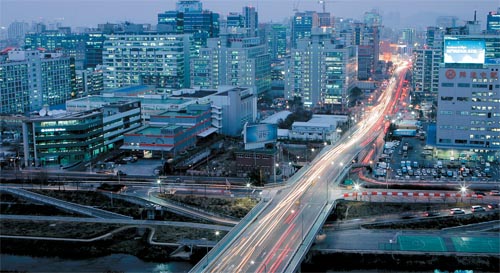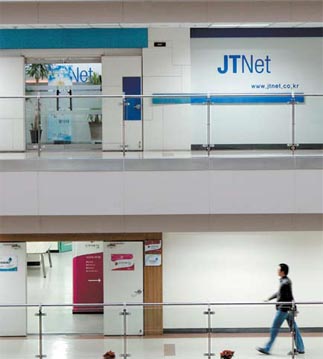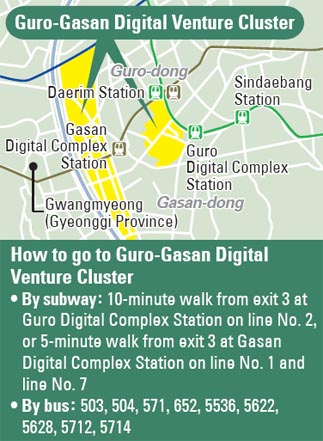High-tech cluster coming of age in a hurry

A bird’s-eye view of the digital venture cluster, the largest of its kind in Korea. The 1.98 million-square-meter (489-acre) area is home to 9,415 small and midsize firms that employ 120,632 people.
The 36-year-old programmer thinks policy bigwigs involved in the project should take a stroll around G Valley, the nickname for the Guro-Gasan digital venture cluster in southwestern Seoul, a technology-focused business belt that is modeled after Silicon Valley in San Francisco.
Yoon - the programming team manager at Mcookie, a game developer located in G Valley - first proposed the idea jokingly. Letting officials run their scenarios through a city-building simulation game he developed in 2007, Yoon thought, could maybe help them make better decisions related to the Sejong project.

The inside of Mario Tower, a typical modern office building within the Guro-Gasan digital venture cluster in southwestern Seoul. Scores of small information and technology companies are located in this 15-story building. By Jeon Min-kyu
“Here, you can experiment with anything,” Yoon said. “If you fail with one idea, you can try another. That is probably why so many companies gather here.”
Although G Valley is now home to the country’s largest cluster of start-up companies, some locals have never heard of it.
Not long ago, the area was better known as the Guro Industrial Complex, which heavily contributed to the country’s rapid economic growth from the 1960s to the 1980s.
Most of the companies in the Guro Industrial Complex have moved outside the metropolitan area, to other cities in Korea or overseas, seeking cheaper places to run businesses. Over the years, however, new firms specializing in information technology and bio-energy began to fill the void.
The transformation was accelerated by the government’s official designation of the area as a digital complex in December 2000. The smokestack factories that used to symbolize Guro have been transformed into modern buildings filled with individual companies in small offices.

About 78 percent of the companies in G Valley are focused on information and technology, but biotech firms are also planting roots here at a quickening pace, according to the Korea Venture Business Association, an organization of venture companies.
That transformation from manufacturing to digital businesses brought many changes to the area.
One of them: women now make up a much larger share of the workforce, according to Park Tae-geun, manager of the association.
“When this was a factory area, the streets used to be filled with male workers wearing dark jumpers marked with company logos,” Park said. “But nowadays, many women in pretty clothes, who look just like they jumped off the pages of a magazine, are seen walking in streets.”
The eating scene has shifted as well.
In the past, most of the restaurants in the area were old-fashioned eateries and joints selling cheap local liquors such as makgeolli and soju. But now, family restaurants and premium coffee houses are mushrooming in the region, part of an effort to attract a younger and wealthier demographic.
“Only two years ago, there was just one Starbucks coffee shop in the neighborhood, but now many similar coffee brands are seen on every corner,” said Kim Yoon-hee, an assistant manager of the association.
The formation of an IT cluster, according to people with knowledge of the area, was tied to the fact that the complex is in an ideal region that helps companies save costs yet still attract solid talent.
Many IT companies used to be based in Gangnam, specifically in the area known as Tehran Valley. But a fair share of them moved out as real estate prices starting escalating rapidly. When the tech bubble burst in the early 2000s, these companies could not afford to pay the rising rents, so they looked for cheaper options.
The further away a firm gets from the downtown core, though, the harder it can be to lure talent, especially workers in younger generations. So companies started eyeing the area that straddles the Guro and Geumcheon districts, which is cheaper yet still in Seoul. The area also has a few extra attributes going for it, namely an industrial infrastructure already in place and some local government support.
Kim Moon-wook, president of Dori Games, a game maker, is one of the latest companies to move its home offices to the cluster.
“We were based in Yeoksam-dong but moved here two months ago because it was getting difficult to afford the cost,” said Kim.
Apart from the low property cost, Kim said the Guro-Gasan cluster has many other benefits.
“It is easier to collaborate with other game makers here. The Korea Venture Business Association and the Korea Industrial Complex are providing many chances for collaborative works,” said Kim. “Taxes and other forms of incentives are also provided.”
According to the association, the cluster generated 501.0 billion won worth of goods and services in October alone, lifting its cumulative production for the year to 4.72 trillion won and its cumulative export total to $1.12 billion.
That represents about 83 percent of the 2009 production target set by the Korea Industrial Complex and roughly 81 percent of the 2009 export target.
Recognizing the potential of the area, the Guro and Geumcheon districts are trying to generate as much support and awareness as possible. Guro, for instance, is now using the motto “Digital Guro.”
“We hope the days will come sooner rather than later when many venture companies in the cluster grow into big companies,” said Park Jun-ho, an official of the Guro District Office. “Who knows? Maybe this cluster will become a model business hub for the country.”
By Moon Gwang-lip [joe@joongang.co.kr]










with the Korea JoongAng Daily
To write comments, please log in to one of the accounts.
Standards Board Policy (0/250자)